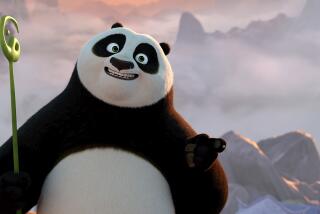China had to import ‘Kung Fu Panda’
If there was ever a subject and a genre tailor-made for China’s film industry, it would seem to be “ Kung Fu Panda.” The panda is a national symbol, kung fu was developed here, China is all the rage globally, and animation is a state priority.
Then along comes Hollywood and turns the story of a panda who dreams of becoming a kung fu master into a global blockbuster-- and the most successful animated film in Chinese history. Sure, DreamWorks animation added its own touches -- for example, the panda’s father is a goose and there’s a bra made of noodle bowls -- but still the film has prompted a bit of soul-searching here. Why couldn’t we do this? What does it say about the Chinese film system?
Competing against Hollywood is never easy. But filmmakers in China shoulder some heavy baggage.
Consider the protagonist, Po.
The idea of making a film in which the hero, a Chinese national symbol, is a bit of a slouch just doesn’t wash. Which is also something Po isn’t particularly good at.
“Both Asia and the West have elite culture, but in China, Confucian forms dominate,” said Zhang Nian, a culture critic. “This panda is a flunky who haggles for his own selfish ends.”
Chinese film heroes are generally long on perfection and short on foibles. The men are handsome and robust and the women fair and graceful. And they generally don’t have Po’s willpower problem, eating disorders or tendency to run from danger.
“Given the political overlay, it becomes very difficult in China to make movies,” said Stan Rosen, director of the East Asian Studies Center at USC. “If you start off with a fat, lazy panda, a national symbol, someone is bound to come along and say, ‘We can’t give an image to the world that China is fat and lazy.’ ”
Then there’s basic biology. How could a panda have green eyes and a goose for a father?
“Our education system doesn’t give rein to imagination,” said Zhou Liming, a film critic. “Instead, it usually tries to curb it.”
Added to the no-no list for Chinese animators is raciness, particularly in a children’s movie. Witness Po’s joking use of noodle bowls to simulate breasts and his bid to protect his family jewels -- known in Chinese as “little brothers” -- in the middle of a fight.
“All the censors can think about is how to teach children,” said a film executive who asked not to be identified because of his company’s ongoing relations with the government. “And they don’t seem to understand that edgy, hip entertainment can actually result in some pretty effective teaching.”
Another creative gap centers on the film’s portrayal of teachers.
The idea that Po would lift a hand to his kung fu teacher, a raccoon named Shifu, is beyond the pale in Confucian China, with its deep respect for elders. Nor would a teacher in a Chinese film be so “weak” as to show sympathy for the evil snow leopard character, Tai Lung.
“If ‘Kung Fu Panda’ were produced in China, audiences would be sniping at the director for not setting a good example,” said Cao Sidong, a movie critic and promoter.
Others say change is coming slowly. “In cartoon school, we learned to combine instruction and entertainment,” said Chen Ming, vice president of Beijing Crystal Film & Animation. “But we had a certain tradition before China opened up, and it’s hard to get away from that overnight.”
Some experts blame China’s lack of animation success on small film budgets, less advanced technology and the widespread availability of pirated DVDs, which discourage people from going to theaters. “It’s a vicious cycle,” said Miao Di, a film professor with Communication University of China in Beijing. “Our system doesn’t encourage popular films.”
Others express frustra- tion with censorship rules that change with the political winds.
In 2006, film director Lu Chuan agreed to produce 100 five-minute cartoons for the 2008 Beijing Olympics built around the five fuwa, or friendly children, mascots -- one of which is a panda.
One script called for a fuwa to act badly, realize his mistake and be redeemed. When Lu submitted it to censors and the Beijing Olympic Committee, however, it was rejected as too negative, he said, as were virtually all of the other 99 mini-plots.
“Every character had to be perfect,” Lu said. “You couldn’t have violence or blood, which meant no confrontation or drama. It was impossible to create anything. In the end, I didn’t want to waste two years of my life on this propaganda, so I quit.”
The industry’s lackluster results come despite Beijing’s extensive support for the animation industry and hope that China might one day challenge Hollywood.
This year, the government has doled out more than $28 million in animation subsidies and preferential financing. It has banned foreign cartoons during prime-time hours. And it requires television stations to show seven domestic cartoons for every three foreign ones.
But most consumers have easy access to foreign cartoons through pirated DVDs.
At the Beijing Crystal Film & Animation company, 270 programmers sit behind computers in a dimly lighted open-plan office manipulating digital martial arts masters and busty maidens.
Producer Li Zhenhua’s cursor deftly jumps between split screens as he illustrates how faces and body types are modified and built up by amending the characters’ bone structure, metal armor and silk robes to create ancient warriors.
Near Li’s desk is a small theater, and downstairs there’s an academy training aspiring animators. The company, one of China’s largest animators, churns out 1,500 minutes’ worth of feature films and video games annually. But none of its projects have anything close to “Kung Fu Panda’s” four-year development period, $130-million budget or blockbuster success.
“ ‘Kung Fu Panda’ was a terrific movie,” Li said, dressed in shorts at a desk strewn with soda cans, cigarette packs and a tea maker. “We need to learn from Hollywood.”
More to Read
Start your day right
Sign up for Essential California for news, features and recommendations from the L.A. Times and beyond in your inbox six days a week.
You may occasionally receive promotional content from the Los Angeles Times.






